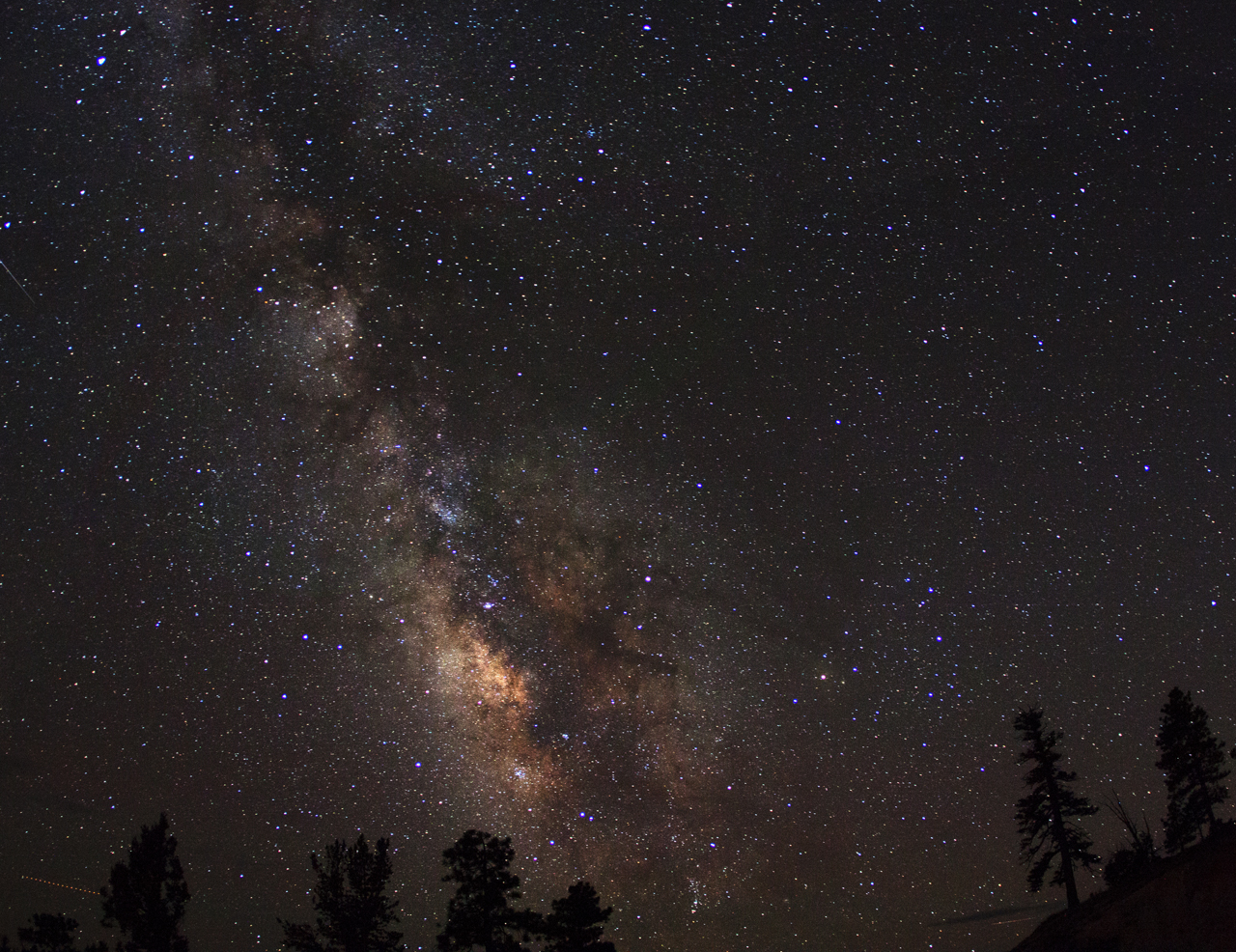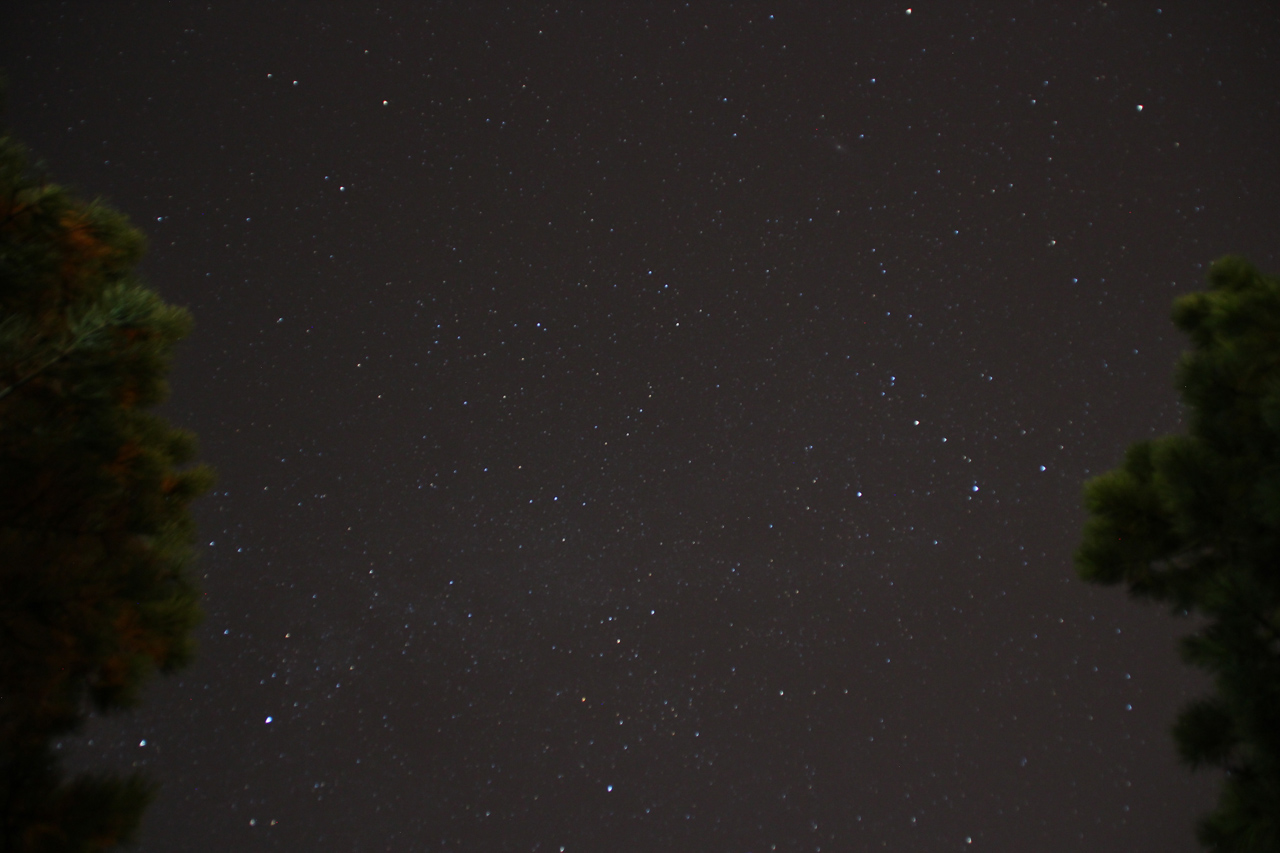
Derby and District Astronomical Society
The Milky Way
[Gallery]
| This image of the Milky Way was captured from Pitlochry on the 14th November 2025 by Chris Callaway. It stretches from Cygnus at the top of the picture down to Auriga at the bottom. The star Vega is visible near the upper left corner of the image, and Capella near the middle close to the bottom edge. The Pleiades are visible in the bottom right corner and the Andromeda Galaxy (M31) at right centre. Chris used a Canon R6 Mk II camera with a 16mm Canon lens. 8 x 30 second exposures were taken at f4.0 and ISO 1600, on a Manfrotto tripod, plus darks and flats. Initial stacking was done in Sequator before processing in PixInsight and Photoshop. Image Credit: Chris Callaway. |

|
| Russ Pollard captured this image of the Milky Way on the 28th September 2025 from the Aberbran Fawr Campsite in the Brecon Beacons, during the annual DDAS stargazing trip. Russ took the photo using a Google Pixel 8 phone using Astro mode. Image Credit: Russ Pollard. |

|
| This image of the Milky Way was taken by Russ Pollard on the 25th September 2025 from the Aberbran Fawr Campsite in the Brecon Beacons, during the annual DDAS stargazing trip. Russ took the photo using a Google Pixel 8 phone placed face down on a table with the camera looking directly overhead and using a long exposure in Astro mode. Image Credit: Russ Pollard. |

|
| Chris Callaway created this image of the Milky Way from data gathered on the 1st July 2025 in Berchtesgaden Germany. The camera used was a Canon 5D Mk III at ISO 1000 on a photographic tripod, with a Canon 17-40mm zoom lens set at 17mm and f/4. 10 x 30 second subs were taken along with 6 darks. The images were stacked in Sequator. Image Credit: Chris Callaway. |

|
| This picture of the Milky Way was taken in late September 2024 from the Brecon Beacons by Chris Callaway. It is a single shot using a Canon 5D camera, a 17-40 mm lens at 19 mm and f/4.5, a 13 second exposure, and ISO 5000. Image Credit: Chris Callaway. |

|
| Chris Callaway took this spectacular image of the Milky Way in September 2024 from Saint Pierre d'Albigny in France. Also notable are the Pleiades star cluster near the horizon at lower left, and the Andromeda Galaxy just to the lower left of center. Chris used a ZWO 178 camera with the supplied all sky lens. The image is comprised of 20 x 15 second exposures. Image Credit: Chris Callaway. |

|
| The following two images of the Milky Way were captured by Pete Hill on the 20th October 2022 while down under, at Yulara, just outside Uluru, Australia. They were taken using a Canon 450D DSLR and Canon 15 mm fisheye lens, manual focus, and mounted on a tripod with a cable shutter release. Settings were ISO 1600, f2.8, and an exposure of 25 seconds. The view looks due west and was taken between 22:00 and 23:00 local time. Pete comments that he "...managed to find some darkish spots at the back of the hotel. Second image bit nearer hotel, more stray light, but caught meteor in bottom left corner. Stumbling around in the shadows of the hotel bumped (literally) into an American doing the same thing!" Image Credit: Pete Hill. |

|

|
| Pete Hill took this spectacular image of the summer Milky Way from Bryce Point, at the north end of Bryce Canyon, Utah on the 16th August 2017. Pete used a Canon 450D camera with a Canon 15mm fisheye lens at F2.8, ISO 1600, and a 26 second exposure. Two shots were merged in Photoshop to create this image. Image Credit: Pete Hill. |

|
| This image of the summer milky way was captured by Robert Seymour on the 3rd September 2016 from the Midi-Pyrénées region in south-west France. Rob used a Canon EOS 6D camera with a 16-35mm wide-angle F4 lens. The image is a single 30 second exposure at 16mm, F4.5 and ISO 3200. Rob comments: 'The aim was to try and image the Milky Way, with the summer constellations. It was a bit late to see Scorpius, which was setting, although you just about see Mars and Saturn low down. But the Sagittarius 'teapot' is there, as are a few other notables..M4, M8, the Scutum star cloud etc. Can you spot the 'Coathanger' at the top?'. The glow at the bottom left is from the nearby town of Prayssac. Image Credit: Robert Seymour. |

|
| Chris Newsome captured this view of the winter sky including the Milky Way between Orion and Cassiopeia on the 29th December 2014 by the A57 at Ladybower Reservoir looking towards the Snake Pass and Manchester. It contains at least nine and a half constellations! Jupiter is to the upper left together with part of Leo, Hydra below that, and Cassiopeia to the upper right. The FOV diagonally across the frame is about 180deg. Taken with a Canon 40D, 8mm full frame fisheye lens, 4x30secs at ISO1600 (plus darks), stacked in DSS, processed in CS6. The slight Akira Fujii effect was created using IRIS software. You may have to scroll to see the whole picture! Image Credit: Chris Newsome. |
|
|
| Simon Allcock took this picture of the Milky Way from Boulder, Colorado, whilst on holiday in 2013. The view is looking up towards the zenith and shows the Milky Way running between the trees from Cygnus on the left through Cassiopeia on the right. The Andromeda Galaxy can be seen towards the upper part of the picture in the 1 o'clock position from the centre of the image. Simon took the picture with his Canon EOS 600D camera resting on the grass! He used a 10 second self timer remote control function to remove the shutter vibration, and a 30 second exposure time at F3.5 and ISO 800. He comments that it was so clear at night that it was awesome to look up with no light pollution! Image Credit: Simon Allcock. |

|
| This picture by Simon Allcock shows the Milky Way running across the lower part of the image from Cassiopeia at the middle lower edge to Perseus at lower right. The Andromeda Galaxy can be seen to the left of centre of the picture and The Plieades at the upper right edge. Simon took the picture while on holiday in Boulder, Colorado in 2013 using a Canon EOS 600D camera. He used a 10 second self timer remote control function to eliminate shutter vibration, and a 30 second exposure at F3.5 and ISO 800. Image Credit: Simon Allcock. |

|
| This wide photo of the summer Milky Way was taken on the 12th August 2013 by Chris Newsome. The image is centred on the star Deneb in Cygnus with Vega (in Lyra) at the top and Altair (in Aquila) at the right. The Andromeda galaxy, M31, can be seen in the lower half of the image. No, there are no Perseids! Chris used a Canon 40D with a 10mm lens at f/3.5 and 640 ASA. The image comprises 62 frames of 30 seconds each. The camera was piggybacked on his Meade ETX 105. Image Credit: Chris Newsome. |

|
| DDAS member Chris Newsome shot this photo of the Milky Way from Cathedral Gorge, Utah, USA, while on holiday there in August 2012. It shows the Cygnus region. Taken with a Canon 40D and a 10-22mm lens. Image Credit: Chris Newsome. |

|
| The Milky Way is framed by the open dome of the DDAS Flamsteed Observatory in this image taken by Chris Newsome on the 26th September 2009. The 'W' of Cassiopeia lies at the lower part of the opening while Deneb and the stars of Cygnus fill most of the upper two thirds. The Double Cluster in Perseus is also visible just below Cassiopeia. Chris used a Canon 400D camera with a 10mm super-wide angle lens at 1600ASA. The image is a single 30 second exposure. Image Credit: Chris Newsome. |

|
| For the Perseid meteor shower maximum on the 12th August 2007 Chris Newsome travelled 200 miles to the to the far west of Pembrokeshire and took this 30 second exposure of Cygnus, the Milky Way and a Perseid (right side of frame). The picture was taken using an unmodified Canon EOS300D camera with a 27 mm lens at 800ASA. It was then processed slightly in CS2. Chris comments: "It was fantastic to see the Milky Way in all it's glory. The nearest sodium light was around 10 miles away and shielded by the Preseli Mountains. The Perseids were coming through the atmosphere thick and fast and bright! It got to a point that there were so many stars on view that it was difficult to make out some of the constellations at times!" Image Credit: Chris Newsome. |

|
[Top]